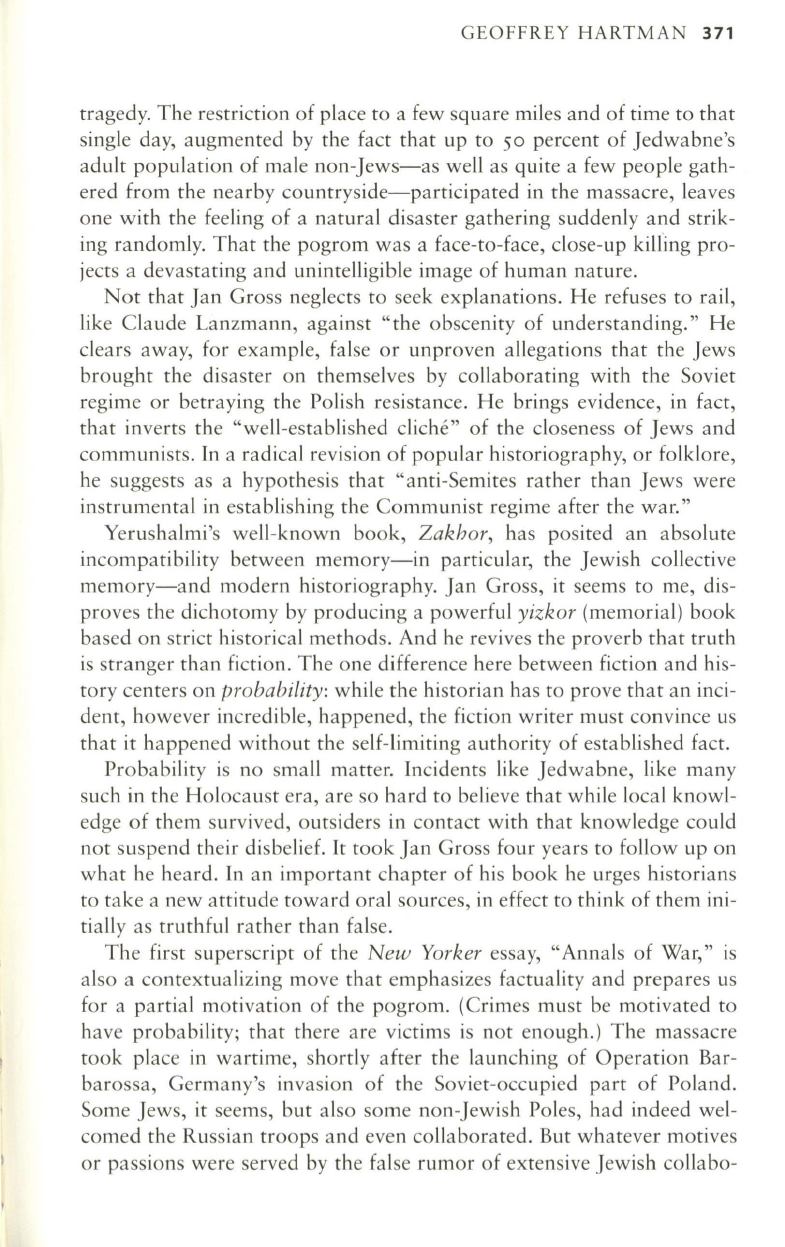
GEOFFREY HARTMAN
371
tragedy. The restriction of place to a few square miles and of time to that
single day, augmented by the fact that up to 50 percent of Jedwabne's
adult population of male non-Jews-as well as quite a few people gath–
ered from the nearby countryside-participated in the massacre, leaves
one with the feeling of a natural disaster gathering suddenly and strik–
ing randomly. That the pogrom was a face-to-face, close-up killing pro–
jects a devastating and unintelligible image of human nature.
Not that Jan Gross neglects to seek explanations. He refuses to rail,
like Claude Lanzmann, against "the obscenity of understanding." He
clears away, for example, false or unproven allegations that the Jews
brought the disaster on themselves by collaborating with the Soviet
regime or betraying the Polish resistance. He brings evidence, in fact,
that inverts the "well-established cliche" of the closeness of Jews and
communists. In a radical revision of popular historiography, or folklore,
he suggests as a hypothesis that "anti-Semites rather than Jews were
instrumental in establishing the Communist regime after the war."
Yerushalmi's well-known book,
Zakhor,
has posited an absolute
incompatibility between memory-in particular, the Jewish collective
memory-and modern historiography. Jan Gross, it seems to me, dis–
proves the dichotomy by producing a powerful
yizkor
(memorial) book
based on strict historical methods. And he revives the proverb that truth
is stranger than fiction. The one difference here between fiction and his–
tory centers on
probability:
while the historian has to prove that an inci–
dent, however incredible, happened, the fiction writer must convince us
that it happened without the self-limiting authority of established fact.
Probability is no small matter. Incidents like Jedwabne, like many
such in the Holocaust era, are so hard to believe that while local knowl–
edge of them survived, outsiders in contact with that knowledge could
not suspend their disbelief.
It
took Jan Gross four years to follow up on
what he heard. In an important chapter of his book he urges historians
to take a new attitude toward oral sources, in effect to think of them ini–
tially as truthful rather than false.
The first superscript of the
New Yorker
essay, "Annals of War," is
also a contextualizing move that emphasizes factuality and prepares us
for a partial motivation of the pogrom. (Crimes must be motivated to
have probability; that there are victims is not enough.) The massacre
took place in wartime, shortly after the launching of Operation Bar–
barossa, Germany's invasion of the Soviet-occupied part of Poland.
Some Jews, it seems, but also some non-Jewish Poles, had indeed wel–
comed the Russian troops and even collaborated. But whatever motives
or passions were served by the false rumor of extensive Jewish collabo-


